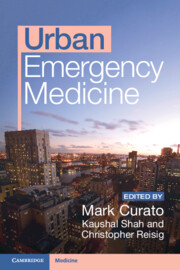Book contents
- Urban Emergency Medicine
- Urban Emergency Medicine
- Copyright page
- Contents
- Contributors
- Preface
- Chapter 1 Caring for the Homeless
- Chapter 2 Disruptive and Dangerous Agitation
- Chapter 3 Penetrating Trauma
- Chapter 4 Substance Use
- Chapter 5 Human Trafficking
- Chapter 6 Travelers from Overseas
- Chapter 7 HIV, AIDS, and Tuberculosis
- Chapter 8 Asthma
- Chapter 9 Physician/Patient Discordance
- Chapter 10 LGBTQIA+ Care
- Chapter 11 Child Maltreatment
- Chapter 12 Care of Vulnerable Elders
- Chapter 13 Civil Unrest: Caring for Police and Protesters
- Chapter 14 Terrorism and Mass Casualty Incidents
- Chapter 15 Overcrowding, Triage, and Care Rationing
- Index
- References
Chapter 13 - Civil Unrest: Caring for Police and Protesters
Published online by Cambridge University Press: 20 July 2023
- Urban Emergency Medicine
- Urban Emergency Medicine
- Copyright page
- Contents
- Contributors
- Preface
- Chapter 1 Caring for the Homeless
- Chapter 2 Disruptive and Dangerous Agitation
- Chapter 3 Penetrating Trauma
- Chapter 4 Substance Use
- Chapter 5 Human Trafficking
- Chapter 6 Travelers from Overseas
- Chapter 7 HIV, AIDS, and Tuberculosis
- Chapter 8 Asthma
- Chapter 9 Physician/Patient Discordance
- Chapter 10 LGBTQIA+ Care
- Chapter 11 Child Maltreatment
- Chapter 12 Care of Vulnerable Elders
- Chapter 13 Civil Unrest: Caring for Police and Protesters
- Chapter 14 Terrorism and Mass Casualty Incidents
- Chapter 15 Overcrowding, Triage, and Care Rationing
- Index
- References
Summary
Incidents of civil unrest are increasing in frequency across the United States and may involve protests or demonstrations in response to political or economic activities, responses to concerts or sporting events, or in response to controversial actions by law enforcement. During these incidents, injuries may occur either in isolation or in associated interactions with law enforcement personnel. There are specific patterns of injury that are unique to protests and encounters with law enforcement, and it is important for the urban emergency medicine practitioner to have a fundamental understanding of the management of common injuries associated with law enforcement interactions. This chapter will highlight the general principles of emergency department care during periods of civil unrest, including best practices for interacting with both public safety personnel and private citizens. Patterns of injury will be explored, including injuries occurring from kinetic impact projectiles, conducted electrical weapons, and crowd dispersal agents, in addition to other less-common injury patterns encountered during periods of civil unrest.
- Type
- Chapter
- Information
- Urban Emergency Medicine , pp. 161 - 172Publisher: Cambridge University PressPrint publication year: 2023
References
- 1
- Cited by

